|
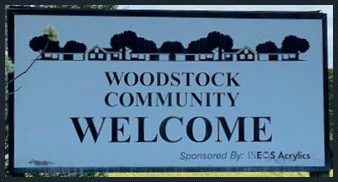
The community of Woodstock, originally known as Rembert Town, lies
about halfway between the Wolf River and the
City of Millington, spread out on both sides of
US 51. The main road through this part of
northern Shelby County prior to the opening of
US 51 was named Old Millington Road, parts of
which are still an available thoroughfare in the
area.
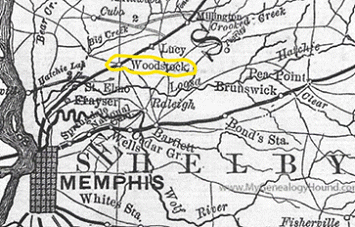 |
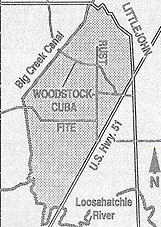 |
|
1880 |
1990 |
In the late 1800s, the railroad (Memphis and
Paducah, and later named Chesapeake, Ohio and
Southwestern, then Illinois Central, and today
the Canadian National or CN) was the major mode
of “modern” transportation from Memphis to
Covington, with Frayser, Woodstock, Lucy,
Millington, Kerrville, Tipton, Atoka, and
Brighton being the key stops along the route.
The Woodstock area was known for its timber, and
took its name from a stop for wood to fire early
locomotives. The early trains had to have towers
and racks of wood along the way. At this
location in 1875, wood and water were supplied
by Benjamin Hawkins. He also gave land for St.
Ann’s Episcopal Church. Samuel Rembert II had
the first store. He enjoyed reading Walter Scott
who wrote of “Wood Stock.” Rembert combined the
two words as the name of the wood stop. Once the
vast virgin forests were cleared, cash crop
farming like cotton began . . .
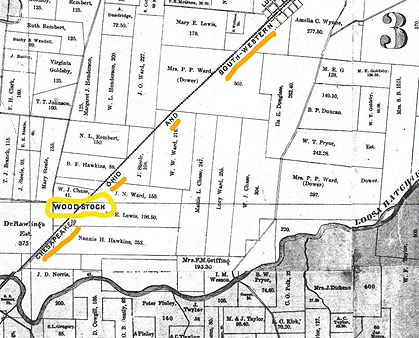
Prior to the introduction of rail to the area,
the previous arteries for transportation derived
from trails and pathways developed by meandering
animals, then followed by Native Americans,
European explorers, migrants and finally
American settlers with then plank roads, postal
and stagecoach routes.
Settlers in the area in the early 1800’s tended
to settle on or near the banks of Big Creek,
which begins in southern Tipton County and
meanders southward to the Wolf River through
this area.
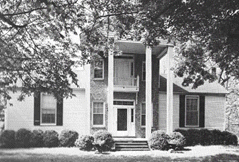 Seven Hills Plantation, named for the
seven hills in Rome, is the oldest farm in
Shelby County (1821) with five generations of
the Rembert family living there until the late
20th century.
Seven Hills Plantation, named for the
seven hills in Rome, is the oldest farm in
Shelby County (1821) with five generations of
the Rembert family living there until the late
20th century.
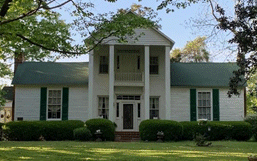 Andrew
Rembert was the descendant of French Huguenots
who came to the American colonies in the 1800’s
seeking religious freedom, In 1819, the year
that Shelby County was established, he came to
West Tennessee area to take up a land grant of
5,000 acres for service in the Revolutionary
War. He started building his house in north
Shelby County before his death in 1845. Andrew
Rembert was the descendant of French Huguenots
who came to the American colonies in the 1800’s
seeking religious freedom, In 1819, the year
that Shelby County was established, he came to
West Tennessee area to take up a land grant of
5,000 acres for service in the Revolutionary
War. He started building his house in north
Shelby County before his death in 1845.
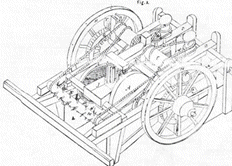 Andrew’s son, Samuel Stokes Rembert, finished
the house and one known as an creative type with
inventions such as the
Andrew’s son, Samuel Stokes Rembert, finished
the house and one known as an creative type with
inventions such as the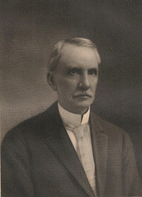 ladies pocket pistol, self-rising bed, fireplace
cook stove and self-greasing buggy wheel. Along
with Jedediah Prescott, he received a patent in
1855 for a cotton picker. He was also an author.
His Philosophy of Life was published in 1866; he
once wrote a book entitled Soaring which
predicted that man someday would be soaring, or
fly; and collected recipes and gave advice in
Culinary Hygiene and Hygienic Cooking. Samuel’s
son, Samuel Stokes Rembert, Jr. (at right),
expanded the family business by renting and
investing in large amounts of cotton land in
Tennessee, Mississippi and Arkansas in the early
2000’s.
ladies pocket pistol, self-rising bed, fireplace
cook stove and self-greasing buggy wheel. Along
with Jedediah Prescott, he received a patent in
1855 for a cotton picker. He was also an author.
His Philosophy of Life was published in 1866; he
once wrote a book entitled Soaring which
predicted that man someday would be soaring, or
fly; and collected recipes and gave advice in
Culinary Hygiene and Hygienic Cooking. Samuel’s
son, Samuel Stokes Rembert, Jr. (at right),
expanded the family business by renting and
investing in large amounts of cotton land in
Tennessee, Mississippi and Arkansas in the early
2000’s.
Ida B. Wells
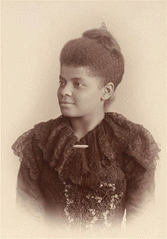 In the early 1880’s, Ida B. Wells was teaching
school in the Woodstock area. Her residence was
in Memphis and she boarded the Chesapeake, Ohio
and Southwestern Railroad (COS) on a daily basis
to get to/from work.
In the early 1880’s, Ida B. Wells was teaching
school in the Woodstock area. Her residence was
in Memphis and she boarded the Chesapeake, Ohio
and Southwestern Railroad (COS) on a daily basis
to get to/from work.
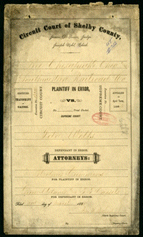 Two
incidents occurred in 1884 and 1885 in which she
was removed from her seat (because the color of
her skin) although she had dutifully purchased a
first class ticket. She sued the COS railroad in
Shelby County Circuit Court, won the lawsuit and
received a $500 settlement. The ruling was later
overturned by the State of Tennessee
Supreme Court in 1887. Two
incidents occurred in 1884 and 1885 in which she
was removed from her seat (because the color of
her skin) although she had dutifully purchased a
first class ticket. She sued the COS railroad in
Shelby County Circuit Court, won the lawsuit and
received a $500 settlement. The ruling was later
overturned by the State of Tennessee
Supreme Court in 1887.
By that
time, Ms. Wells had become a teacher in Memphis
City Schools and hardened herself as a
journalist for the Free Speech and Headlight
newspaper, where she wrote articles about the
inferior public accommodations in Memphis for
people of color. In 1892, three of her friends
were victims of the People’s Grocery lynchings
in Memphis, thus she began her anti-lynching
crusade. Her office was burned and she left
Memphis moving northward to continue her
crusade, as well as campaign for woman's
suffrage and was a founding member of the NAACP
in the first third of the 20th century.
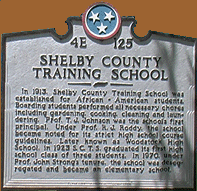 The Shelby County Training School
The Shelby County Training School was established in 1913 for African-American
students. Boarding students performed all
necessary chores including gardening, cooking,
cleaning and laundering. In 1923, SCTS graduated
its first high school class with three students.
Prof. Thomas Jefferson Johnson was the school’s
first principal and had the distinction of being
the first principal in Shelby County to graduate
a 12th grade high school class. Under Prof. R.J.
Roddy, the school became noted for its strict
high school course guidelines and would later
become Woodstock High School (in 1963). In 1970,
under Prof. John Strong’s tenure, the school was
desegregated and became an elementary school.
Today it is Woodstock Middle School.
was established in 1913 for African-American
students. Boarding students performed all
necessary chores including gardening, cooking,
cleaning and laundering. In 1923, SCTS graduated
its first high school class with three students.
Prof. Thomas Jefferson Johnson was the school’s
first principal and had the distinction of being
the first principal in Shelby County to graduate
a 12th grade high school class. Under Prof. R.J.
Roddy, the school became noted for its strict
high school course guidelines and would later
become Woodstock High School (in 1963). In 1970,
under Prof. John Strong’s tenure, the school was
desegregated and became an elementary school.
Today it is Woodstock Middle School.
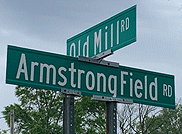
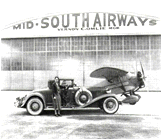 The former site of Armstrong Field is located
about one mile east of US 51 at the southeast
corner of Armstrong Field Road and Old
Millington Road. It was at Armstrong Field that
Memphis had its first scheduled air service and
Vernon Omlie attained his own aviation company –
Mid-South Airways. Armstrong Field operations
were strong enough for Vernon Omlie to venture
into a flying school with offices located in
downtown Memphis. The Armstrong Field
demonstrations also supported the Memphis Aero
Club move to support the appointment of the
city’s first Airport Commission and
establishment of a municipal airport in 1929.
The former site of Armstrong Field is located
about one mile east of US 51 at the southeast
corner of Armstrong Field Road and Old
Millington Road. It was at Armstrong Field that
Memphis had its first scheduled air service and
Vernon Omlie attained his own aviation company –
Mid-South Airways. Armstrong Field operations
were strong enough for Vernon Omlie to venture
into a flying school with offices located in
downtown Memphis. The Armstrong Field
demonstrations also supported the Memphis Aero
Club move to support the appointment of the
city’s first Airport Commission and
establishment of a municipal airport in 1929.
 Phoebe Omlie’s fame as an aerial acrobat and
movie stunt flier was already eclipsed by her
obtaining the first transport license issued to
a woman, and the first license for a woman
aviation mechanic. She was also the first woman
to cross the Rocky Mountains in a light plane,
which she did in 1928 in the Edsel Ford National
Air Tour. The public had come to know the Omlies
and the usefulness of airplanes in 1927, when
they flew daily during the Mississippi River
flood, locating refugees huddled on levees,
delivering medicine and dropping food supplies.
In 1932, President Franklin D. Roosevelt named
her to an Intelligence Department job in the
Aeronautical Bureau. Eleanor Roosevelt named her
on a list of the “11 greatest women in the
nation.” A committee of educators put her on a
list of the 10 most outstanding women in 1941.
Phoebe Omlie’s fame as an aerial acrobat and
movie stunt flier was already eclipsed by her
obtaining the first transport license issued to
a woman, and the first license for a woman
aviation mechanic. She was also the first woman
to cross the Rocky Mountains in a light plane,
which she did in 1928 in the Edsel Ford National
Air Tour. The public had come to know the Omlies
and the usefulness of airplanes in 1927, when
they flew daily during the Mississippi River
flood, locating refugees huddled on levees,
delivering medicine and dropping food supplies.
In 1932, President Franklin D. Roosevelt named
her to an Intelligence Department job in the
Aeronautical Bureau. Eleanor Roosevelt named her
on a list of the “11 greatest women in the
nation.” A committee of educators put her on a
list of the 10 most outstanding women in 1941.
Known as the “godmother” of early Tennessee
aviation, Phoebe F. Omlie started her career as
a barnstormer, wing walker, and stunt pilot. She
and her husband Vernon settled in Memphis in
1922 and opened Mid-South Airways, the first
flying service in the Southeast.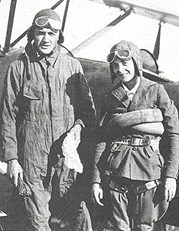 In the late 1920s and early 1930s she attained
prominence representing the Mono Aircraft
Company in national air races. Omlie was the
first woman appointed to a federal aviation
post. From 1933 until 1936 she served as special
assistant for air intelligence with the National
Advisory Committee for Aeronautics (the
predecessor to NASA). From 1941 until 1952 she
worked with the Civil Aeronautics Administration
(the forerunner of the FAA). Omlie introduced
the federal airmarking program through the Works
Progress Administration, and prior to and during
World War II she started schools for primary
flight instruction and aircraft mechanic
training. In the late 1930s Omlie introduced
aviation into the Memphis public school
curriculum, a program that the federal
government adopted for its Civilian Pilot
Training Program. She and W. Percy McDonald,
head of the Tennessee Bureau of Aeronautics,
authored legislation that provided the state
with funds to improve airports and provide pilot
training. In 1942 they started the Tennessee
Women’s Research Flight Instructor School to
ease the pilot shortage in World War II. The
program graduated one class of ten and received
national recognition, but was not adopted and
funded by the federal government. After retiring
from aviation in 1952, Omlie ranched, ran a
restaurant, and traveled as a public speaker.
In the late 1920s and early 1930s she attained
prominence representing the Mono Aircraft
Company in national air races. Omlie was the
first woman appointed to a federal aviation
post. From 1933 until 1936 she served as special
assistant for air intelligence with the National
Advisory Committee for Aeronautics (the
predecessor to NASA). From 1941 until 1952 she
worked with the Civil Aeronautics Administration
(the forerunner of the FAA). Omlie introduced
the federal airmarking program through the Works
Progress Administration, and prior to and during
World War II she started schools for primary
flight instruction and aircraft mechanic
training. In the late 1930s Omlie introduced
aviation into the Memphis public school
curriculum, a program that the federal
government adopted for its Civilian Pilot
Training Program. She and W. Percy McDonald,
head of the Tennessee Bureau of Aeronautics,
authored legislation that provided the state
with funds to improve airports and provide pilot
training. In 1942 they started the Tennessee
Women’s Research Flight Instructor School to
ease the pilot shortage in World War II. The
program graduated one class of ten and received
national recognition, but was not adopted and
funded by the federal government. After retiring
from aviation in 1952, Omlie ranched, ran a
restaurant, and traveled as a public speaker.
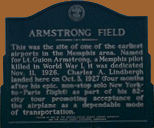 Armstrong Field historical marker [Shelby County
Historical Commission]
Armstrong Field historical marker [Shelby County
Historical Commission]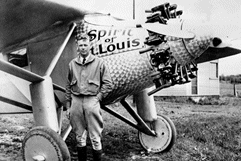
This was the site of one of the earliest
airports in the Memphis area. Named for Lt.
Guion Armstrong, a Memphis pilot killed in Word
War 1, it was dedicated Nov. 11, 1926.
Charles A. Lindbergh landed here on Oct. 3, 1927
(four months after is epic non-stop solo New
York-to-Paris flight) as a part of his 82-city
tour promoting acceptance of the airplane as a
dependable mode of transportation.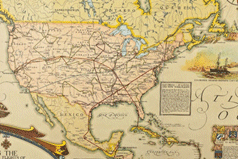
The Daniel Guggenheim Fund sponsored a
three-month nationwide tour of 22,350 miles from
July 20-October 23, 1927,
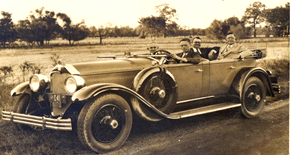 departing
and returning to Mitchell Field on Long Island,
New York. Flying “The Spirit of St. Louis,”
Lindbergh touched down in 49 states, gave 149
speeches and rode in 1,290 miles of parades.
After a parade through Overton Park and Downtown
Memphis, Lindbergh was honored and celebrated at
a dinner and stayed overnight at The Peabody
Hotel in Memphis on October 3. departing
and returning to Mitchell Field on Long Island,
New York. Flying “The Spirit of St. Louis,”
Lindbergh touched down in 49 states, gave 149
speeches and rode in 1,290 miles of parades.
After a parade through Overton Park and Downtown
Memphis, Lindbergh was honored and celebrated at
a dinner and stayed overnight at The Peabody
Hotel in Memphis on October 3.
 Woodstock Saddle Club was formed in April 1961
by a group of horse lovers wanting to promote
competition and fellowship of equine enthusiast
in the area. It is a non-profit organization
that promotes good
Woodstock Saddle Club was formed in April 1961
by a group of horse lovers wanting to promote
competition and fellowship of equine enthusiast
in the area. It is a non-profit organization
that promotes good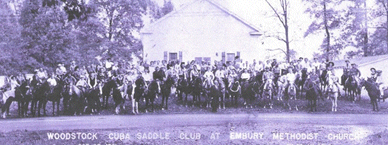 sportsmanship, fun and fellowship in the
Memphis, Millington and surrounding areas. Shows
are on Friday nights, April thru August. A large
portion of our exhibitors are youth. We provide
a safe and Christian environment for families to
come out and enjoy themselves whether they are
horse families or just horse lovers. The
wonderful WCSC Board of Directors and Officers
donate their time and energy to make the shows
run smoothly so families can enjoy themselves.
sportsmanship, fun and fellowship in the
Memphis, Millington and surrounding areas. Shows
are on Friday nights, April thru August. A large
portion of our exhibitors are youth. We provide
a safe and Christian environment for families to
come out and enjoy themselves whether they are
horse families or just horse lovers. The
wonderful WCSC Board of Directors and Officers
donate their time and energy to make the shows
run smoothly so families can enjoy themselves.
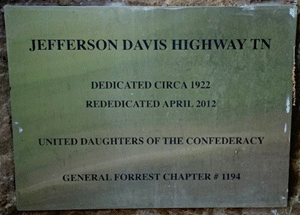 |
While being known as Old Millington
Road, US 51 was also designated at
the Jefferson Davis Highway through
Tennesse, Kentucky and Illinois.
This memorial appears on the portion
of Old Millington Road on the west
side of US 51 just north of the
intersection with Little John Road. |
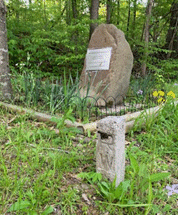 |
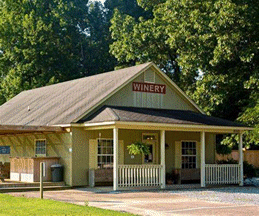
 Old Millington Winery is where the music meets
the wine. Established in 2000, the Old
Millington Winery is a family-owned
boutique-style winery nestled in the rolling
hills of West Tennessee 14 miles north of
downtown Memphis, near Millington. The winery
offers award winning wines from dry to sweet,
including a most popular Blackberry, Maggie’s
Rose and Muscadine wines. There is live music on
the grounds on Sunday afternoons in the Spring
and Fall.
Old Millington Winery is where the music meets
the wine. Established in 2000, the Old
Millington Winery is a family-owned
boutique-style winery nestled in the rolling
hills of West Tennessee 14 miles north of
downtown Memphis, near Millington. The winery
offers award winning wines from dry to sweet,
including a most popular Blackberry, Maggie’s
Rose and Muscadine wines. There is live music on
the grounds on Sunday afternoons in the Spring
and Fall.


Woodstock
Hills Golf Course to Mirimichi & Justin
Timberlake
 Dr. B.G. Mitchell opened the Woodstock Hills
Country Club in 1978 on 300 acres hat he and his
sisters inherited. A slow market interfered with
efforts to establish a residential community
surrouding the golf course, and in 1990,
Dr. B.G. Mitchell opened the Woodstock Hills
Country Club in 1978 on 300 acres hat he and his
sisters inherited. A slow market interfered with
efforts to establish a residential community
surrouding the golf course, and in 1990,
 the
property was sold. Known for the next 19 years
as Big Creek Golf Course, the property is now
home to Mirimichi Golf Course, developed by
local Shelby Forest denizen and future star of
stage and screen, Justin Timberlake. Mirimichi
is a Native American word meaning “place of
happy retreat.” Mirimichi was the first golf
course in North, South or Central America to
receive a certified status from the
international Golf Environment Organization
(GEO). Additionally, it was the first course in
the United States to be designated as a
Certified Audubon International Classic
Sanctuary, making it the only golf course in the
world to hold both designations. the
property was sold. Known for the next 19 years
as Big Creek Golf Course, the property is now
home to Mirimichi Golf Course, developed by
local Shelby Forest denizen and future star of
stage and screen, Justin Timberlake. Mirimichi
is a Native American word meaning “place of
happy retreat.” Mirimichi was the first golf
course in North, South or Central America to
receive a certified status from the
international Golf Environment Organization
(GEO). Additionally, it was the first course in
the United States to be designated as a
Certified Audubon International Classic
Sanctuary, making it the only golf course in the
world to hold both designations.




Today about
to miles east of US 52 via Armstrong Field Road
is the Memphis International Raceway (formerly
known as Memphis Motorsports Park). MIR is an
auto racing park located near the Loosahatchie
River. The facility opened in 1987 with a drag
strip and 1.8-mile (2.9 km) road course. It
includes a 3/4-mile tri-oval short track, built
in 1998, which once hosted the NASCAR Xfinity
Series and Camping World Truck Series, as well
as an ASA Late Model Series race. The 4,400-foot
(1,340 m) drag strip hosts events such as
International Hot Rod Association (IHRA) World
Finals and Nitro Jam, Professional Drag Racers
Association (PDRA), HOT ROD Power Tour, Super
Chevy Show, Fun Ford Series and Mega Mopar
Action Series.
  
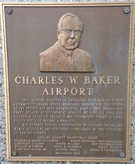
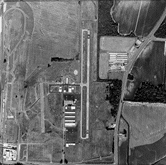 And,
next to the raceway is the Charles W. Baker
Airport, named for a leader in the Shelby County
Quarterly Court for the north Shelby County area
in the middle of the 20th century, and whose
name is also on the Baker v. Carr lawsuit heard
in 1962 by the United States Supreme Court
determining “one man, one vote” legislative
reapportionment nationwide. Charles W. Baker
Airport is owned and operated by the
Memphis-Shelby County Airport Authority.
Services include fuel, hangar and ramp space,
aircraft parking and more. The facility occupied
259 acres and was opened in 1959. And,
next to the raceway is the Charles W. Baker
Airport, named for a leader in the Shelby County
Quarterly Court for the north Shelby County area
in the middle of the 20th century, and whose
name is also on the Baker v. Carr lawsuit heard
in 1962 by the United States Supreme Court
determining “one man, one vote” legislative
reapportionment nationwide. Charles W. Baker
Airport is owned and operated by the
Memphis-Shelby County Airport Authority.
Services include fuel, hangar and ramp space,
aircraft parking and more. The facility occupied
259 acres and was opened in 1959.
 Woodstock in Soul Man lyrics. During times of
nationwide civil unrest in America in the 1960s,
David Porter and Isaac Hayes wrote lyrics for
the song “Soul Man,” sung by the R & B duo of
Sam & Dave. It rose to #2 on the charts in 1967
and in 1968 was awarded the 1968 Grammy Award
for Best Rhythm & Blues Group Performance, Vocal
or Instrumental. David Porter, a student at
Booker T. Washington High School in Memphis,
states that the lyrics “Comin’ to you on a dusty
road . . .” and “I was educated at Woodstock . .
.” came from his earlier high school experiences
in the 1960s of visiting the students at
Woodstock High School.
Woodstock in Soul Man lyrics. During times of
nationwide civil unrest in America in the 1960s,
David Porter and Isaac Hayes wrote lyrics for
the song “Soul Man,” sung by the R & B duo of
Sam & Dave. It rose to #2 on the charts in 1967
and in 1968 was awarded the 1968 Grammy Award
for Best Rhythm & Blues Group Performance, Vocal
or Instrumental. David Porter, a student at
Booker T. Washington High School in Memphis,
states that the lyrics “Comin’ to you on a dusty
road . . .” and “I was educated at Woodstock . .
.” came from his earlier high school experiences
in the 1960s of visiting the students at
Woodstock High School.
Sources for information provided in the
Woodstock Commmunity are:
Images Of America: Millington by Dr. Rita
Hiltenbrand Hall
Good Abode by Perre Magness
Historic Shelby County by Dr. John Harkins
Paul R. Coppock’s Midsouth, Vol. 4, 1979-1982 by
Paul Coppock
Walking On Air by Janann Sherman
|